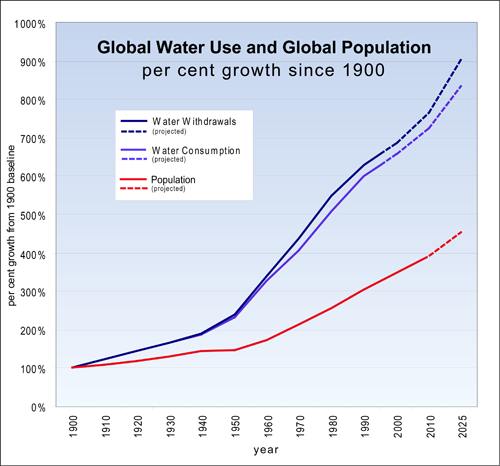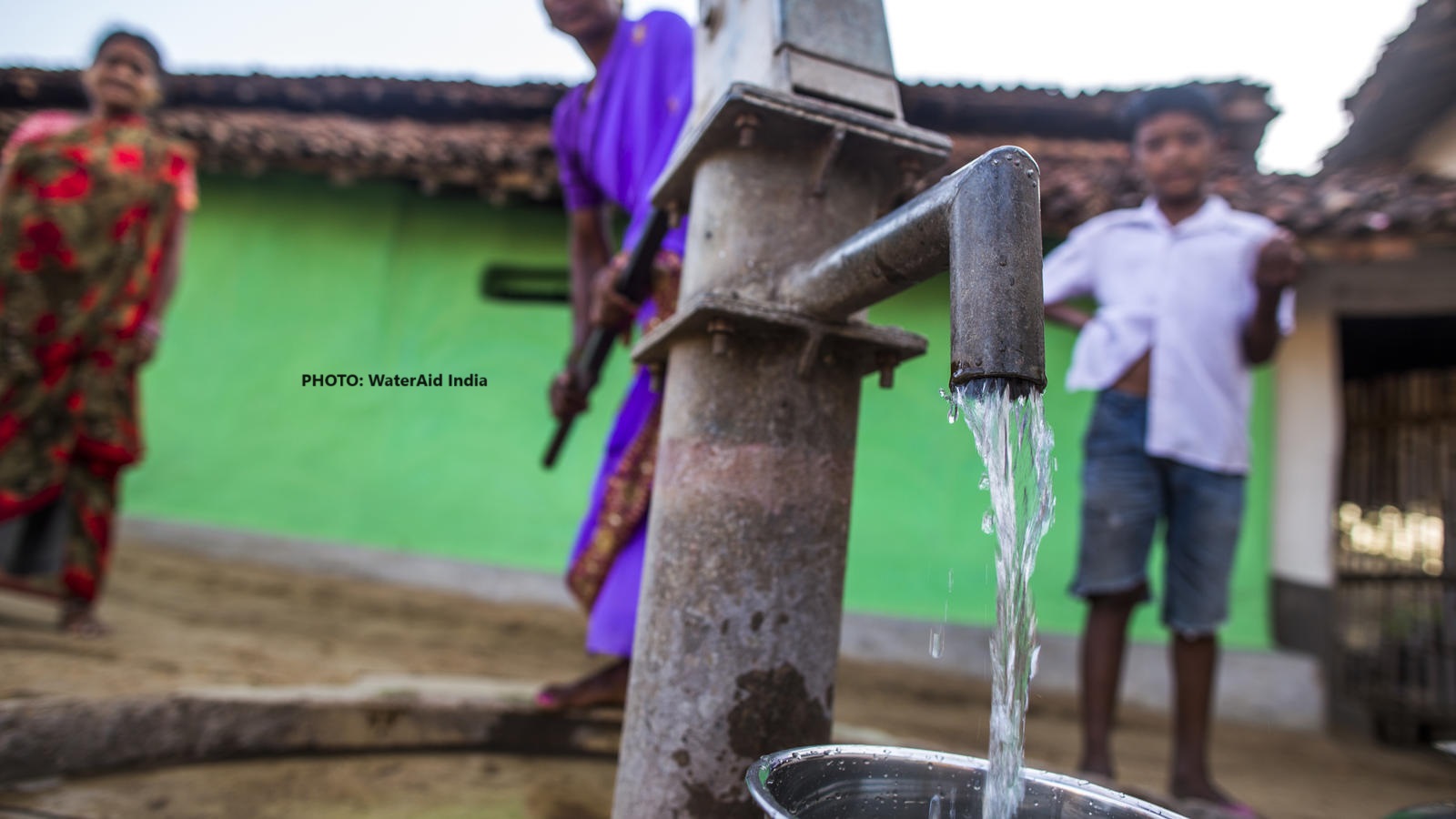- Four billion people — almost two thirds of the world’s population — experience severe water scarcity for at least one month each year.
- Over two billion people live in countries where water supply is inadequate.
- Half of the world’s population could be living in areas facing water scarcity by as early as 2025.
- Some 700 million people could be displaced by intense water scarcity by 2030.
- By 2040, roughly 1 in 4 children worldwide will be living in areas of extremely high water stress.
↑

The effects of climate change are causing water to become increasingly unpredictable. The storage of terrestrial water, including that in soil, snow, and ice, is decreasing. Consequently, this leads to heightened water scarcity, disrupting various societal activities.
India’s Looming Water Crisis
According to the National Commission for Integrated Water Resource Development of MoWR, the projected water requirement by 2050 under high usage conditions is estimated to be 1,180 BCM, while the current availability stands at 695 BCM. Although the total potential water availability in the country is slightly lower than this projected demand, at 1,137 BCM. Hence, there’s an urgent need to enhance our comprehension of water resources and usage patterns and implement measures to enhance the efficiency and sustainability of water usage.
India is currently facing its most severe water crisis in history, with over 600 million people already experiencing significant water shortages. The depletion of critical groundwater resources, which contribute 40% to our water supply, is occurring at unsustainable rates.
The frequency of droughts is increasing, posing significant challenges for the country’s rain-dependent farmers, who account for 53% of agricultural activity. Furthermore, the available water is often contaminated, with up to 70% of our water supply affected, resulting in nearly 200,000 deaths annually. Interstate water disputes are also escalating, with seven major conflicts currently ongoing, highlighting the inadequacy of existing frameworks and institutions for national water governance.
If no significant changes are made soon, the situation will deteriorate further. Estimates suggest that by 2030, India’s water demand will surpass supply by a factor of two, leading to severe water scarcity affecting hundreds of millions of people.
Impact of Shifting Winter Patterns on North India
At the end of last year, we saw a long dry spell in the most densely populated North Indian region. What’s left of that dry spell in 2023–24 is sad proof of the changing climate leading to more drought and floods, making weather patterns unpredictable. Indeed, this is especially true now that winter is slowly ending in North India. One of the changes observed with it is the shift of winter storms to later parts of winter.
Previously, these storms were a part of a natural cycle and would occur on time. However, they are becoming a double-edged sword that has the capability of worsening things. It not only means having less water available at the right time but also increases the chances of terrible floods. Both ways, its impact on the environment is huge, and that’s what is scaring the scientists. Let’s discuss more about the issue and see how it can impact the states of North India.
Understanding Western Disturbances
The way these western disturbances behave has changed clearly over the past few years. These disturbances play a big part in the winter rain that falls in the Himalayas. Many years ago, these wet winds would always show up on time. But these days, they’re known for being late. Because of this delay, the area becomes disturbed, which throws off the natural balance of how water is distributed and how it rains. These delays not only change the timing of weather trends but also make it harder for societies that depend on regular climate cycles to deal with problems.
Research Reveals a Disturbing Trend
A new study published in the journal Weather and Climate Dynamics has raised the worries of common masses and scientists alike. The study suggests big changes in the climate of north India which tends to affect millions of people.
According to the statistics, there has been an alarming rise: the number of western disturbances that have happened in the 2023 summer, from April to July, has grown by an amazing 60%. This surge not only messes up the expected snowfall that is needed for water reservoirs but also signals the start of a heavy rainstorm. Because of this, there is either no rain on time or there are heavy flood rains which damage both property and human lives. Recently, the events that occurred in Uttarakhand and Delhi are prime examples of such events that we can focus on. Such events not only affect the local regions or populations but can alter the natural cycles of many other surrounding areas.
The Reasons for this Trend
This change in the weather is causing a lot of different problems, which are caused by a number of different factors. The changes in the subtropical jet stream are some of the most important things that cause these changes. Because the Tibetan Plateau is getting warmer, this high-altitude airflow is changing in big ways. In the past, it was this high-altitude airflow that directed disturbances in the western area. The rising of this plateau, which is a real basis of how the world’s climate works, is getting worse because of climate change. Because of this, the jet stream gets stronger, which sends more and stronger storms into North India.
When these things come together, they make a perfect storm that changes the weather. The way air currents move is changing because of global warming, and the effects can be felt all over the world. At the moment, this is showing up in places like North India, where risks and weaknesses are growing. Having a deep knowledge of these mechanisms is very important for coming up with effective ways to adapt to and lessen the effects of a climate that is becoming less stable.
The Role of Global Warming
The impact of global warming is huge in the complicated web of climate dynamics, and it can affect every single person on Earth. Not being able to follow the normal movement patterns of the jet stream is one of the most important effects of this event. A high-altitude airflow called the jet stream stays at latitudes further to the south for long periods in the spring and summer. This happens when temperatures keep going up and the gap in temperature between the equator and the poles keeps getting smaller.
As a result of this extended stay, late-season storms are more likely to get stronger and more severe, which goes against the usual rules of yearly weather cycles. Because of this, the once-reliable cycle of winter storms in North India changes dramatically. This brings about a new era of climate instability and unpredictability which is a very interesting development.
Remember, climate change isn’t just a threat because it changes when weather events happen; it’s also a threat because it changes the way rain and snow fall. North India is being hit hard by heavy rain now that the snow is melting fast. People will be flooded by this sudden change in rainfall, and it will also destroy the basic structures that societies and ecosystems are built on. Floods are replacing the steady and gradual pattern of spring, which was once an important resource for river networks and farming systems. They are causing damage with their sudden appearance. A delicate balance in the water balance has been altered, which is making things very hard for both plants and animals. The dangers of flooding and not having enough water are linked, making the problem more difficult and wide-ranging.
Increased Water Security
Climate change and water security are interconnected issues with significant implications. This has impacts on the environment, societies, and sustainable development. The repercussions are palpable throughout North India, painting a disquieting picture of what the future holds. Residents of North India are apprehensive that decreased snowfall and an increase in late-season storms will become more frequent occurrences, with far-reaching effects across the region. The delicate equilibrium between available water resources and the growing demands of the populace is on the verge of collapse.
This poses a threat to the very essence of life and livelihoods in the region, carrying existential significance. With each passing season, the looming spectre of water scarcity and perilous floods looms large over communities already grappling with the multifaceted challenges of climate change.
To confront these pressing issues head-on and chart a course towards a more stable future, immediate action is imperative.
What Next?
By 2060, North India is expected to experience severe and permanent shortages of freshwater because climate change is reducing its availability. Referred to as the “water tower” of Asia, the Tibetan Plateau, which plays a critical role in determining water availability and is highly susceptible to the impacts of climate change, situated at the “Roof of the World”, provides freshwater for nearly 2 billion people downstream, as highlighted by an international team of researchers.
According to the researchers, the effects of climate change on both historical and projected terrestrial water storage (TWS) in the Tibetan Plateau have not received sufficient attention, despite their profound importance.
A study, published in the journal ‘Nature Climate Change’ under the title ‘Climate change threatens terrestrial water storage over the Tibetan Plateau’, warns of irreversible declines in freshwater storage in the region due to the combined effects of climate change and inadequate climate policies. The study foresees a complete collapse in water supply for Central Asia and Afghanistan, along with a near-total collapse for Northern India and Pakistan by the middle of the century.
In these challenging times, the imperative for action is more pressing than ever. Greater efforts must be devoted to enhancing the resilience of environments against climate change. This can be achieved through an approach encompassing long-term water management, the construction of resilient infrastructure, and the initiation of community-based adaptation programs. It necessitates concerted efforts from lawmakers, stakeholders, and communities to devise innovative solutions and implement them swiftly and decisively.
Moreover, it cannot be overstated how crucial it is for people worldwide to take robust action on climate change. Only by addressing the root causes and fostering global environmental sustainability can we safeguard vulnerable areas like North India from the severe impacts of climate change.
Conclusion
When confronted with challenges, we are allowed to collaborate and innovate. Embracing a comprehensive strategy to both adapt to and mitigate the impacts of climate change will facilitate our navigation through the turbulent waters ahead, fostering a more stable and sustainable future for generations to come. The time for action is now. A closer examination of India’s climate challenges, such as delayed winter storms and their implications for water security, underscores the imperative to combat climate change and bolster the resilience of vulnerable regions. Only through collective effort and coordinated action can we confront the daunting realities of a shifting climate and chart a course towards a more sustainable future.
Water for peace
Water can create peace or spark conflict.
When water is scarce or polluted, or when people have unequal, or no access, tensions can rise between communities and countries.
More than 3 billion people worldwide depend on water that crosses national borders. Yet, only 24 countries have cooperation agreements for all their shared water.
As climate change impacts increase, and populations grow, there is an urgent need, within and between countries, to unite around protecting and conserving our most precious resource.
Public health and prosperity, food and energy systems, economic productivity and environmental integrity all rely on a well-functioning and equitably managed water cycle.
Creating a positive ripple effect
The theme of World Water Day 2024 is ‘Water for Peace’.
When we cooperate on water, we create a positive ripple effect – fostering harmony, generating prosperity and building resilience to shared challenges.
We must act upon the realization that water is not only a resource to be used and competed over – it is a human right, intrinsic to every aspect of life.
This World Water Day, we all need to unite around water and use water for peace, laying the foundations of a more stable and prosperous tomorrow.
References
https://www.unwater.org/water-facts/water-scarcity
https://www.theweek.in/wire-updates/national/2024/03/12/lst2-research-snow-india.html






Leave a Reply
You must belogged in to post a comment.